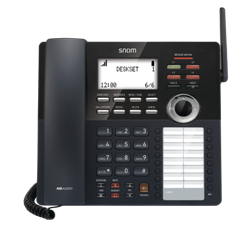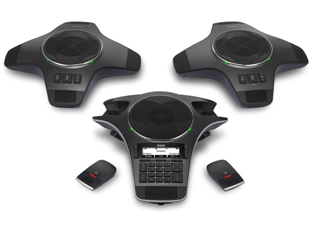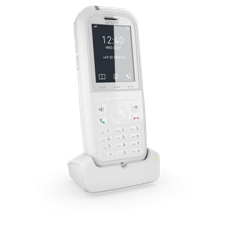
Disruptive – it’s probably the most accurate word to describe what’s happened across the globe in 2020. The COVID-19 pandemic disrupted every aspect of life – work, school, home, social. Exceptional circumstances have impacted just about everything people do.
The impact on businesses can’t be understated. Within weeks, millions of companies were forced to relocate their workforces from office spaces to their homes. That meant a very rapid transition to new tools and technologies to support remote workers. Even for companies that already had some remote employees, moving to a fully remote organization meant change, and it wasn’t always easy. As companies are developing new strategies for bringing employees back into offices, they struggle with how to comply with new health and safety mandates while maximizing office productivity.
“Companies are struggling with the new normal, which changes every day,” said Simon Bradbrook, sales engineer at Snom. “We’re more than a few months into this situation, and many companies are still trying to sort out how to merge remote working and office re-opening strategies efficiently.”
Bradbrook noted three significant – if not staggering – statistics:
- 64% – the percentage of employees working remotely
- 148% – the increase in remote working in 2020
- 80% – the increase in the use of collaboration and video conferencing apps
Still, it’s not a new trend – just one that has been drastically accelerated by the pandemic. Companies were already leveraging remote workers to expand their reach and hiring capabilities and support workforce demands for better work-life balance. It’s also not a trend that is going to reverse itself: According to Gartner (News - Alert), 82% of business leaders say they will continue to enable remote working at least part-time once the pandemic subsides
The New Workplace Normal
It all means that companies are developing entirely new strategies to support a combination of work environments, including office, remote, and hybrid, permanently. In many cases, though, their existing technology or rapid response solutions they implemented at the start of shutdowns don’t enable the efficiency, flexibility, and mobility they need.
The new normal will require rethinking office layouts, repositioning desks and cubicles, redesigning conference rooms, and a technology strategy to enable all workers to function efficiently and seamlessly, regardless of their physical environments.
With the increase in distributed workforces, voice communications have become more critical than ever, increasing the value of flexible, cloud-based phone systems. But, the oft-forgotten component of phone systems is the phone itself. With the growth of digital collaboration tools, many have predicted the end of physical desk phones for years. That hasn’t come to pass yet, partially because so many companies haven’t fully embraced digital transformation and partly because office workers still want physical phones’ features and feel.
With the new workplace realities, phones are going to become more critical than ever.
Not Your Dad’s Office Phone (News - Alert)
 While phones will continue to be a permanent fixture in workplaces, they have to embrace the flexibility and mobility of the new modern workplace. That means phone manufacturers must not only understand new workplace models but adapt their solutions to accommodate them.
While phones will continue to be a permanent fixture in workplaces, they have to embrace the flexibility and mobility of the new modern workplace. That means phone manufacturers must not only understand new workplace models but adapt their solutions to accommodate them.
“It’s not only had an impact on how we work but on the solutions we are delivering and how they need to be delivered,” said Matt Hickey (News - Alert), vice president of sales for service providers and strategic alliances at Snom. “The key for us is to understand how COVID has impacted individual partners and customers because no one size fits all, and we have a host of new products slated to come out that are influenced heavily by the way the workforce is transforming.”
Health and safety requirements are a significant factor in how businesses will operate. They will need to take extra steps to accommodate distancing and other safety requirements in office environments, which means adopting multiple approaches to workforce arrangements:
- Redesigning office spaces,
- Moving some staff into permanent work from home arrangements,
- Creating a rotational hybrid model where groups of employees switch between in-office and remote environments.
These new workplace arrangements have one requirement in common – flexibility and mobility. More specifically, they demand office phones that can support that flexibility, which is why Snom is heavily emphasizing its DECT (News - Alert) products, which makes it simple to move phones within offices or between the office and home environments.
“The beauty of the technology is it becomes very mobile,” explained Bradbrook. “It’s staggering to hear the number of remote workers and supporting the need to stagger workforces and allow employees to switch between the office and home is very easy with DECT technology.”
Users can connect their DECT wireless desk phones or handsets wherever they are, using a USB dongle, making it extremely simple to move them between different work environments and ensure the same quality office experience anywhere. With its range, which is far superior to Bluetooth, DECT phones also allow users to move around their homes while on calls, making it easier for them to manage work-life balance without disrupting workflows. For instance, DECT phones enable employees to find a quiet place to take calls when needed for employees without a dedicated office space.
Also, as businesses reconfigure their office spaces, they will require connectivity at each desk, requiring costly new wiring. DECT phones eliminate that need and allow companies to place phones anywhere they are needed without any additional wiring (only the DECT base stations require cabling) to be set up conveniently in locations with existing drops.
“It’s going to be hard enough for companies to figure out what to do around distancing, so we’re betting heavily on the wireless, which will help them avoid having to rewire buildings and offices to accommodate new layouts,” Hickey added.
Beyond the desktop
The office environment, though, extends beyond the individual desk. Traditionally, the conference room has been one of the critical areas for collaborating. But, with new distancing requirements, we’re not going to see the same crowded conference rooms with employees huddled around conference phones.
conference room has been one of the critical areas for collaborating. But, with new distancing requirements, we’re not going to see the same crowded conference rooms with employees huddled around conference phones.
For meetings, Snom has developed its C620 DECT conference phone, which allows the conference phone to move from location to location in the office and expands the conference environment to larger or multiple spaces with wireless microphones and extension speakers. Now, teams can be split into smaller groups to attend meetings in several office spaces with the same high-quality voice. The DECT conference phones and extension units sync to the DECT access points, creating a genuinely wireless conferencing system.
“It’s got social distancing written all over it,” said Hickey.
Safety conscious tech
 Aside from enabling social distancing, the current environment has changed the way Snom physically builds its products. It will add additional health and safety measures to its devices. Snom currently produces healthcare-specific handsets with antibacterial materials, and arent company VTech makes antibacterial hotel room phones. From now on, Snom will expand that antibacterial feature to all its handsets, desk phones, and conference solutions.
Aside from enabling social distancing, the current environment has changed the way Snom physically builds its products. It will add additional health and safety measures to its devices. Snom currently produces healthcare-specific handsets with antibacterial materials, and arent company VTech makes antibacterial hotel room phones. From now on, Snom will expand that antibacterial feature to all its handsets, desk phones, and conference solutions.
Why DECT?
Snom sees the value in DECT technology, and for a good reason – it’s part of Snom’s parent company’s strong legacy.
“VTech has always been known for its mobility solutions with DECT products, and they have come to the forefront now,” noted Hickey. “The key for us is to understand how COVID-19 has impacted individual partners and customers because no one size fits all.”
With that in mind, DECT technology’s benefits are enabling Snom to develop vertically focused solutions that help specific markets deal with their new normal.
- Range – DECT provides a vastly superior range to Bluetooth technology, increasing mobility and flexibility for individual users and allowing companies to increase coverage within office spaces while ensuring all users have a high-quality experience. Anyone who has used a DECT device understands.
- Voice quality – engineers developed DECT for voice, not data. WiFi (News - Alert) phones run on data infrastructure and are impacted by bandwidth and security issues. With a DECT mesh network, the technology guarantees users crystal clear signaling for all calls.
- Security – DECT is a secure technology that isn’t susceptible to Bluetooth devices’ interference when multiple devices are used in the same area.
- Distancing – With the flexibility of dedicated wireless solutions, companies can quickly adjust to new circumstances as needed without costly wiring costs.
That said, Snom is keenly aware it needs to remain open to meet the varying needs of different businesses and users, which is why it will continue to support connectivity with DECT, SIP, and Bluetooth.
“One of the fundamentals we live by is we have to remain open to different technologies,” said Hickey. “We will continue to enable people to communicate how they want to, and we have to be open so everyone can integrate.”
Snom’s product development team is also influenced by other user trends shaping workplace dynamics. It has redefined its roadmap to accommodate many of the needs evident over the past year. That includes new desk phone models that will consist of video capability and touchscreens built on the Android platform and integration with many of the popular collaboration apps that have become second nature during the pandemic and will remain part of business culture in the future.
The company is also looking to develop other products outside its traditional space, including devices that offer integrated DECT and BT flexibility.
“This pandemic has reshaped the way we plan and develop our product lines,” Hickey added.
Integration partners
The same approach to openness extends to Snom’s technology partners. Snom’s designs its devices to work with all voice providers, and the company’s goal is to provide voice devices for every user. Snom takes pride in the steps it takes to collaborate with call control providers to ensure interoperability and simplify deployment with various service providers’ solutions. The call control providers are its pipeline to end-users, making certification on their platforms a necessity.
“We work very closely with them to make sure we have the building blocks in place,” said Bradbrook. “Every service provider does things a little differently and puts their twists on things, but by working with the call control providers first, we can twist with the service providers much more easily.”
Once products are certified with the various call control platforms, Snom then works with service providers to understand how the devices need to function with their multiple services. By building these deep relationships with its partners, Snom can work closely to adapt its products whenever new services are introduced to maximize end-user benefits, including firmware updates, software versions, and APIs to connect Snom devices to function correctly in the service environments.
Snom holds a distinct advantage when it comes to customization – it owns all of its manufacturing operations, which gives it much more flexibility to work with partners on their specific needs. This autonomy helps in terms of application integration, but even physical features on the devices and branding. It also enables Snom to more rapidly verticalize solutions, such as healthcare, hospitality, retail, or SMB markets.
The same production flexibility also enables Snom to effectively address companies at either end of the size spectrum, with single base station solutions for companies with just a few users, to multi-cell solutions capable of supporting 1,000 base stations and 4,000 users. Most vendors cannot offer that range, which also opens up opportunities for its service provider partners, who can deliver to a wide range of business customers.
“We have re-engineered several products after listening to what our partners have told us,” Hickey explained. “They have helped us understand how we can provide blanket products but verticalize and specialize them for service providers, while also focusing on the end-user experience.”
Why now?
The question so many are asking is, “Why should I invest in technology at a time when budgets are tighter than ever?” While that may be true, the simple fact is every business is facing many of the same challenges around distancing, remote working, health and safety, and, of course, budgets. Snom’s solutions provide companies – from those with only a few employees to enterprises with thousands –with the flexibility, mobility, voice quality, and security they need to adapt to these constantly evolving needs.
Simultaneously, Snom’s collaboration with service providers ensures those vendors can maximize their value proposition with devices that meet the new physical workplace needs and have been certified with underlying call control platforms and are compatible with each provider’s voice services.
The productivity enhancements and flexibility Snom provides should be plenty of motivation, but the company is adding incentives with rebates on its handsets, desk phones, and conference phones.
The fact is that many of the accommodations companies are making today will become part of their permanent work environments. Knowing that the sooner they provide employees the tools to function as efficiently as possible, the more productive their organizations will be as a whole. Whether they are moving to mostly remote workforces, hybrid models, or expanding office space to accommodate everyone safely, Snom’s investment in DECT solutions ensures customers have the tools to provide operational flexibility and continuity, regardless of how their needs may change in the future.
“We’re betting very heavily on the DECT solutions today, but more importantly on the DECT solutions we’re delivering tomorrow,” noted Hickey.
Snom's Chris Trittin will be speaking on this very topic, addressing how businesses can effectively support new workplace paradigms, at
MSP Expo 2021 in Miami, Florida, or June 24, 2021, in his session,
Wireless Office: Supporting all Workforce Models
Edited by
Erik Linask





